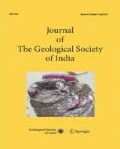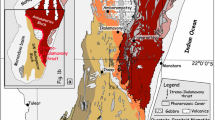Abstract
Quartz reefs that constitute the most spectacular feature of the Bundelkhand massif of Central India are as yet riddled with controversy. We consider the NE-SW trending quartz reefs and the NE-SW trending brittle-ductile shear system developed outside the quartz reefs to constitute a single tectonic fabric of the massif. The study of structural features of the quartz reefs and the associated NE-SW trending shear zones coupled with the mineralogical and structural features suggests that the quartz reefs represent strike-slip dominated vertical to subvertical shear zones with dominantly sinistral sense of shear. The loci of the quartz reefs constitute the large scale fractures developed as a consequence of extensional processes in this part of Central India. These fractures were the sites for later emplacement of siliceous magmatic melt, commonly known as quartz reef that was also responsible for the mineralization of some base metals as well as pyrophyllite and diaspore. The lithotectonic system of these quartz reefs thus developed was later on subjected to strike-slip movements. A generalized model of large scale extensional tectonics during the Proterozoic times has thus been suggested for the development of the NE-SW tectonic fabric of the Bundelkhand massif.
Similar content being viewed by others
References
Acharyya, S.K. (2003) The nature of Mesoproterozoic Central Indian Tectonic Zone with exhumed and reworked older granulites. Gondwana Res., v.6, pp.197–214.
Basu, A.K. (1986) Geology of parts of the Bundelkhand Granite Massif, Central India. Rec. Geol. Surv. India Spec. Publ., v.117(2), pp.61–124.
Basu, A.K. (2004) Contemplations on the role of the Bundelkhand massif on structural evolution and mineralization in the western Indian craton, Rajasthan, India. Geol. Surv. India, v.72, pp. 325–344.
Basu, A.K. (2007) Role of the Bundelkhand Granite Massif and the Son-Narmada megafault in Precambrian crustal evolution and tectonism in Central and Western India. Jour. Geol. Soc. India, v.70, pp.745–770.
Basu, A.K. (2010) Precambrian Geology of the Bundelkhand terrain, Central India and adjecent part of western India. Jour. Econ. Geol. and Georesource Mgmt., v.7(1–2), pp.1–53.
Bhattacharya, A.R. (1986) Wavelength-amplitude characteristics of polyphase folds in the Precambrian Bundelkhand Complex, India. Tectonophysics, v.128, pp.121–125.
Burg J. P. (1999) Ductile structures and instabilities: their implication for Variscan tectonics in the Ardennes. Tectonophysics, v.309(1–4), pp.1–25.
Carreras, J. (2001) Zooming on Northern Cap de Creus shear zones. Jour. Struct. Geol., v.23, pp.1457–1486.
Chardon, D., Jayananda, M, Chetty, T.R.K. and Peucat, J.J. (2008) Precambrian continental strain and shear zone patterns: South Indian case, Jour. Geophys. Res., v.113, B08402, doi:10.1029/2007JB005299.
Chattopadhyay, A. and Khasdeo, L. (2011) Structural evolution of Gavilgarh-Tan Shear Zone, central India: A possible case of partitioned transpression during Mesoproterozoic oblique collision within Central Indian Tectonic Zone. Precambrian Res., v.186, pp.70–78.
Chetty, R.K. and Rao, Y.J.B. (2006) The Cauvery Shear Zone, Southern Granulite Terrain, India: A crustal-scale flower structure. Gondwana Res., v.10, pp.77–85.
Condie, K.C. (2005) Earth as an evolving planetary system: Amsterdam, Elsevier Academic Press. 447p.
Cruz, E. D., Nair, P.K.R. and Prasannakumar, V. (2000) Palghat Gap: A Dextral Shear Zone from the South Indian Granulite Terrain. Gondwana Res., v.3, pp.21–31.
Ghosh, S.K. (2001) Type of transpressional and transtensional deformation. In: H. Ramberg, H.K. Koyi and N.S. Mancktelow, (Eds.), Tectonic modelling. Geol. Soc. Amer., GSA, v.193, pp.1–20.
Jain, S.C, Yedekar, D.B. and Nair, K.K.K. (1991) Central Indian Shear Zone: A major Pre-Cambrian Crustal Boundary. Jour. Geol. Soc. India, v.37, pp.521–531.
Jhingran, A.G. (1958) The problem of Bundelkhand Granites and Gneisses. Presidential Address, Section Geology and Geography. 45th Indian Sci. Congress, Madras.
Misra, R.C. and Sharma, R.P. (1974) Petrochemistry of Bundelkhand Granites and associated rocks of central India. Indian Mineralogist, v.15, pp.43–50.
Mohan, M.R., Singh, S.P., Santosh, M., Siddiqui, M.A. and Balaram, V. (2012) TTG suite from the Bundelkhand Craton, Central India: Geochemistry, petrogenesis and implications for Archean crustal evolution. Jour. Asian Earth Sci., v.58, pp.38–50.
Mondal, M.E.A., Goswami, J.N., Deomurari, M.P. and Sharma, K.K. (2002) Ion microprobe 207Pb/206Pb ages of Zircons from the Bundelkhand massif, northern India, implications for crustal evolution of the Bundelkhand-Aravalli Proto-continent. Precambrian Res., v.117, pp.85–110.
Mondal, M.E.A. (2010) Geochemical evolution of the Archaean-Paleoproterozoic Bundelkhand craton, central Indian shield: Revisited Jour. Econ. Geol. and Georesource Mgmt., v.7, no.1–2, pp.69–80.
Nagraju, P., Labani Ray, Ravi G., Vyasulu, A.V., Singh, S.P. and Roy, S. (2010) Radio elemental abundences and heat production in Bundelkhand craton, Central India. Abstract vol. Geology and Mineral Resourses of Bundelkhand craton at National Seminar, Bindelkhand University, Jhansi, pp.47.
Naqvi, S.M. and Rogers, J.W. (1987) Precambrian Geology of India. Monographs on Geology and Geophysics, 6. Oxford University Press, Oxford, 223p.
Newman, J. and Mitra, G. (1993) Lateral variations in mylonite zone thickness as influenced by fluid-rock interactions, Linville Falls Fault, North Carolina. Jour. Struct. Geol., v.15, pp.849–863.
Pandey, U.K., Bhattacharya, D., Sastry, D.V.L.N. and Pandey, B.K. (2011) Geochronolgy (Rb-Sr, Sm-Nd and Pb-Pb), isotope geochemistry and evolution of the granites and andesite hosting Mohar cauldron, Bundelkhand Granite Complex, Shivpuri District, Central India. Exploration and Research for Atomic Minerals, v.21, pp.103–116.
Pascoe, E.H. (1950) A Manual of the Geology of India and Burma. Geol. Surv. India, Calcutta.
Pati, J.K., Patel, S.C., Pruseth, K.L., Malviya, V.P., Arima, M., Raju, S., Pati, P. and Prakash, K. (2007) Geology and geochemistry of giant quartz veins from the Bundelkhand craton, central India and their implications. Jour. Earth System Sci., v.116, pp.497–510.
Pradhan, V.R., Meert, J.G., Pandit, M.K., Kamenov, G. and Mondal, M.E.A. (2012) Paleomagnetic and geochronologic studies of the mafic dyke swarms of Bundelkhand craton, central India: Implications on tectonic evolution and paleogeographic reconstructions. Precambrian Res., v.198–199, pp.51–56.
Radhakrishna, B.P. and Ramkrishanan, M. (1988) Archaean Proterozoic Boundary in India. Jour. Geol.Soc. India, v.32, pp.263–278.
Rao M.J., Rao, G.V.S. Poornachandra, Widdowson, M. and Kelley, S P. (2005) Evolution of Proterozoic mafic dyke swarms of the Bundelkhand Granite Massif, Central India Curr. Sci., v.88, pp.502–506.
Roday, P.P. Diwan, P. and Singh, S. (1995) A kinematics model of emplacement of quartz reef and subsequence deformation pattern in the central Indian Bundelkhand batholith. Proc. Indian Acad. Sci., Earth Planet. Sci., v.104(3), pp.465–488.
Roy, A., Devarajan, M.K. and Prasad, M.H. (2002) Ductile shearing and syntectonic granite emplacement along the southern margin of the Palaeoproterozoic Mahakoshal supracrustal belt. Evidence from Singrauli area, Madhya Pradesh. Jour. Geol. Soc. India, v.59, pp.9–21.
Sarkar, A., Paul, D.K. and Potts, P.J. (1996) Geochronology and geochemistry of the Mid-Archaean trondhjemitic gneisses from the Bundelkhand craton, Central India. In: A.K. Saha (Ed.), Recent Researches in Geology, v.16, pp.76–92.
Saxena, M.N. (1961) Bundelkhand granites and associated rocks from Kabrai and Mau Ranipur areas of Hamirpur and Jhansi districts, India, Res. Bull. Punjab University, v.12, pp.85–107.
Sengupta, S. and Chattopadhyay, B., (2004) Singhbhum Mobile belt — How far it fits ancient orogen: Geol. Surv. India, Spec. Publ., v.84, pp.23–31.
Sharma, K.K. (2000) Evolution of Archaean Palaeoproterozoic crust of the Bundelkhand craton, northern Indian shield. In: O.P. Verma and T.M. Mahadevan (Eds.), Research Highlights in Earth System Science. DST’s Spec. Publ., Indian Geol. Congress, pp.95–105.
Sharma, R.P. (1979) Origin of the pyrophyllite-diaspore deposits of the Bundelkhand Complex. Mineral. Deposita, v.14 (3), pp.343–352.
Sharma, R.P. (1982) Structure and Tectonics of the Bundelkhand Complex, Central India. Hindustan Publ. Press, New Delhi. Recent. Res. Geol., v.10, pp.198–210.
Singh, S.P. (2012) Archean geology of Bundelkhand craton, central India: An overview. Jour. Gondwana Geol. Mag. Spec. Publ., v.13, pp.125–140.
Singh, S.P. and Dwivedi, S.B. (2009) Garnet-sillimanite-cordierite-quartz bearing assemblages from early Archean supracrustal rocks of Bundelkhand Massif, Central India Curr. Sci., v.97, pp.103–107.
Singh, S.P., Hemraj, Shukla, R.S. Shrivastva, S.K. and Nambiar, K.V. (2008) Granite collapse breccias in Precambrian terrain of Bundelkhand vraton. Jour. Econ. Geol. Georesource Mgmt., v.5, pp.36–52.
Singh, S.P., Singh, M.M., Srivastava, G.S. and Basu, A.K. (2007) Crustal evolution in Bundelkhand area, Central India. Jour. Himalayan Geol., v.28(2), pp.79–101.
Singh, S.P. and Bhattacharya, A.R. (2010) Signatures of Archaean E-W Crustal-Scale Shears in the Bundelkhand Massif, Central India: An Example of Vertical Ductile Shearing. e-Journal Earth Science India, v.3 (IV), pp.217–225.
Srinivasan, V. and Rajeshdura, P. (2010) The Suruli shear zone and regional scale folding pattern in Madurai block of Southern Granulite Terrain, south India. Jour. Earth System Sci., v.119, pp.147–16.
Yedekar, D.B., Jain, S. C., Nair, K.K.K. and Dutta, K.K. (1990) The central Indian collision suture. Geol. Surv. India Spec. Publ., v.28, pp.1–43.
Zegers, T.E., Keijzer, M. De. and Passchier, C.W. (1998) The Mulgandinnah shear Zone; an Archean crustal scale strikeslip zone, eastern Pilbara, Western Australia, Precambrian Res., v.88, pp.233–247.
Author information
Authors and Affiliations
Corresponding author
Rights and permissions
About this article
Cite this article
Bhattacharya, A.R., Singh, S.P. Proterozoic crustal scale shearing in the Bundelkhand massif with special reference to quartz reefs. J Geol Soc India 82, 474–484 (2013). https://doi.org/10.1007/s12594-013-0178-4
Received:
Accepted:
Published:
Issue Date:
DOI: https://doi.org/10.1007/s12594-013-0178-4




